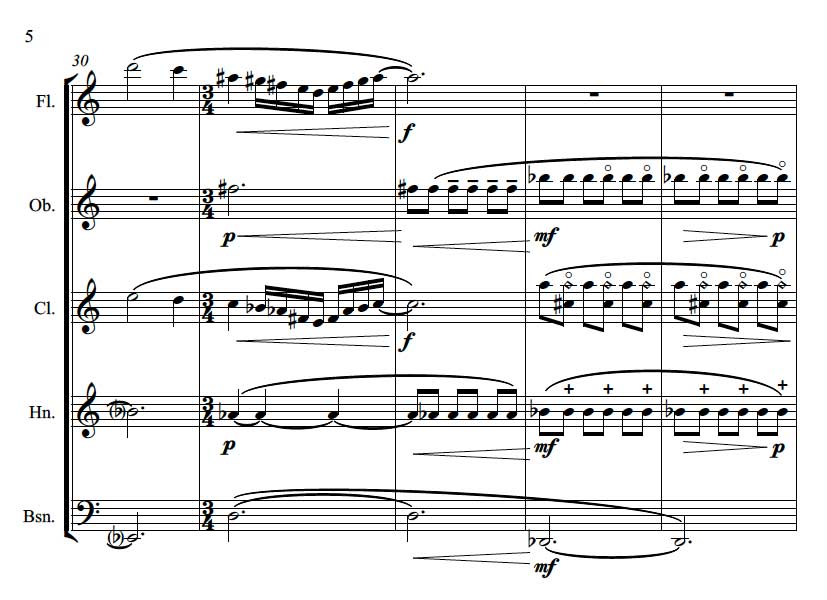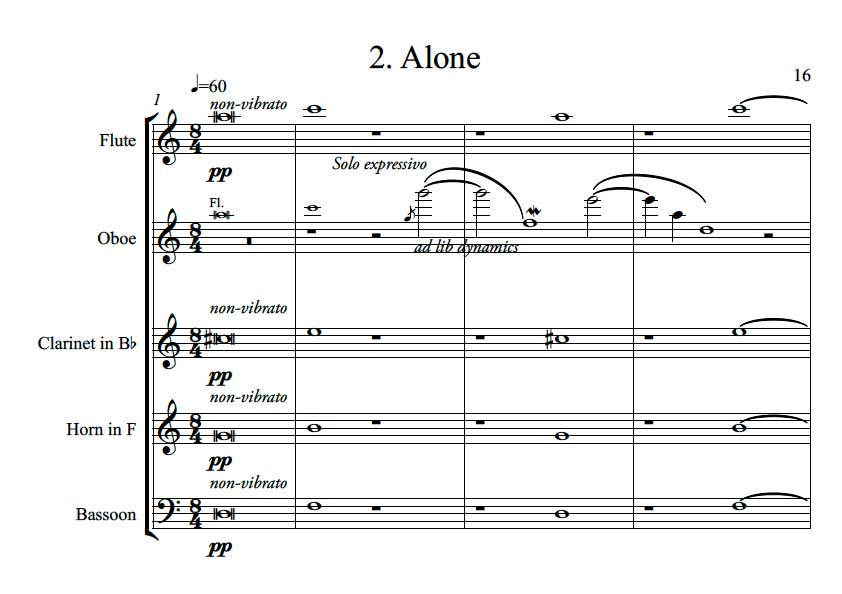No instrument groups have as much personality than do the woodwinds.
This quintet was written for the Alterity Chamber Orchestra‘s principal winds from late May through July 15th 2017 via a call for scores by CF2 . It premiered on October 15th, 2017 at the White House, home of the Timucua Music Foundation. Thank you, Timucua!
1. Nostalgia
The first movement, “Nostalgia,” mutates harmony with alternate fingerings which produce a variety of complex, “impure”, off-pitch or substandard tones that the instruments are not designed to produce. In this movement, I use them in combination with the standard, pure clarinet sounds that classical musicians are required to produce, revealing the boundaries between “right” and “wrong”. Often, this dualistic point of view sets up a resistance to real listening in both the clarinettist and the audience. These marvelous sound-making machines – the woodwinds – have within them a secret garden beyond “perfect”. And like the Japanese art of Kintsugi, these and all so-called “extended techniques”, honor imperfection as a root of beauty.
I found specific alternative fingerings for the clarinet from the website of Heather Roche . Alternative fingerings for the flute, oboe, horn and bassoon came from flutetunes.com, 21stcenturyoboe.com, Wendell World and Mark Charette’s Woodwind Fingering


2. Alone
“Alone” stacks up 7th intervals to support the oboe spread across extreme registers. More than any other instruments, the oboe and bassoon require a narrow set of conditions to work because of their use of a complex double reed. Extreme ranges exacerbate this limitation. I gave the oboe “ad-lib dynamics” so that they could focus on tone quality within extreme registers and long leaps.
The oboe’s melody is a repeated diatonic scale with octave transpositions throughout. Even a scale can be beautiful in the right setting. The rest of the quintet plays pianissimo and non-vibrato under the oboe. The harmonies restate in retrograde diminution from about the halfway point onward.
3. Great River
In this third movement, the horn is featured. It floats over a “Great River” of interlocking arpeggios. The way the harmony came about was through my youngest son Brendon and I trading chords on the piano over his 2016 Christmas break from the University of Florida. One of us would find a chord that we felt was especially pregnant with possibility or emotion and then write it down. Then, the other would find a chord that felt like its complement and write that down. We ended the sequence when we both felt it was over. The challenge of maintaining each six or seven-note chord’s character with only three instruments was met with the use of arpeggios overlapping in stretto. The ever-flexible bassoon provided support to both the horn melody and the higher woodwinds at different times.


4.Cats and Boots
In this final movement, the flute beatboxes a hip-hop ‘beat, over which the ensemble careens from stability to flight and back. It asks a lot of the flutist, who switches back and forth between loud, aggressive beatboxing and normal playing. The beatboxing consists of the popular mouth plosives and drum imitations, but with the flute in the airstream. While fingering the pitch specified, the flutist says “Boo” for a kick drum, a “Ca” to imitate a snare and a “Tss” a hi-hat cymbal.
I learned about beat-box flute “Beatbox Flute 101 – A lesson with Greg Pattillo” from one of my students. The other musicians play rapid jazz-style lines throughout, both in stacks like a sax section to the same line in delayed entrances.
